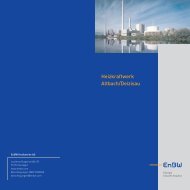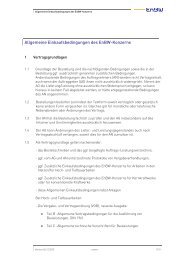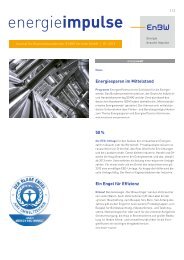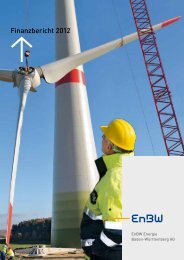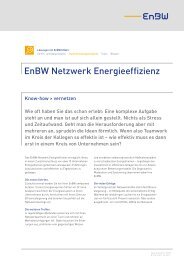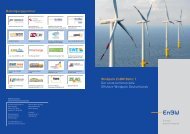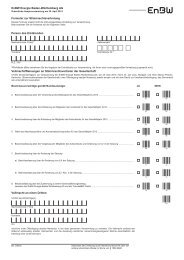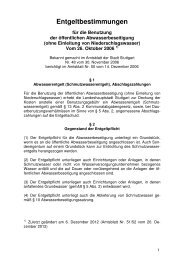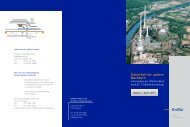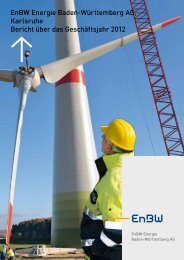2008 I 2009 Sustainability Report - Econsense
2008 I 2009 Sustainability Report - Econsense
2008 I 2009 Sustainability Report - Econsense
You also want an ePaper? Increase the reach of your titles
YUMPU automatically turns print PDFs into web optimized ePapers that Google loves.
Wind energy from offshore<br />
and onshore installations<br />
Wind power plays a key role in the energy<br />
mix of the future – both on land and on the<br />
high seas. EnBW is active in both areas: since<br />
<strong>2008</strong>, we have been developing four major<br />
offshore projects in the North Sea and the<br />
Baltic that, once completed, will supply a total<br />
electrical capacity of around 1,200 MW<br />
and generate roughly 4.3 billion kWh of<br />
electricity every year. The total investment<br />
volume for the four wind energy projects is<br />
in the order of 3 billion €. In 2010, "Baltic 1"<br />
will be the first – and probably the first commercial<br />
offshore wind project in Germany –<br />
of the four projects to go into operation with<br />
an electrical capacity of 48.3 MW.<br />
Capacities in the onshore segment are also<br />
being expanded on a continuous basis,<br />
backed up by the necessary investment. In<br />
February <strong>2009</strong>, for example, EnBW acquired<br />
three onshore wind farms in Lower Saxony<br />
and Brandenburg comprising a total of 26<br />
wind energy installations with a total installed<br />
capacity of 52 MW.<br />
30<br />
Hydroelectric power<br />
Hydroelectric power is currently the most<br />
important source of electricity from renewables<br />
worldwide. The power of water is<br />
a lasting resource; it does not use any primary<br />
energy sources like coal, oil or gas and<br />
therefore does not emit any carbon dioxide.<br />
EnBW has long been involved in this reliable<br />
and climate-friendly form of energy generation.<br />
The share of hydroelectric power in our<br />
generation volume is above the German<br />
average, and this enables us to make an<br />
effective contribution to environmental<br />
and climate protection.<br />
EnBW operates 66 run-of-river power plants<br />
and 12 pumped-storage power plants with a<br />
total installed capacity of around 3,300 MW.<br />
A 67th run-of-river plant is currently being<br />
built at the Neckar barrage in Esslingen and<br />
is scheduled to go into service in 2011. The<br />
construction of the new run-of-river power<br />
plant in Rheinfelden is currently the biggest<br />
new hydroelectric power project in Europe<br />
with a total electrical capacity of around<br />
100 MW. The facility will go into operation<br />
step by step in 2010 and will have the capacity<br />
to generate around 600 million kWh of<br />
electricity a year – enough to provide electricity<br />
to a medium-sized city with 170,000<br />
households. This represents more than<br />
three times the annual volume of electricity<br />
currently produced in Rheinfelden.<br />
We are implementing another large-scale<br />
hydroelectric power project in Iffezheim on<br />
the Upper Rhine. Since the summer of<br />
<strong>2009</strong>, work has been ongoing on turning<br />
the existing power plant into one of the<br />
biggest run-of-river power plants in Europe<br />
by adding a fifth machine. The new turbine<br />
has an output capacity of 38 MW, taking the<br />
overall capacity of the facility to 148 MW.<br />
From 2012, the Rheinkraftwerk Iffezheim<br />
(RKI) power plant will be running on all five<br />
turbines, supplying around 540,000 people<br />
with CO 2-free electricity. The operator is<br />
Rheinkraftwerk Iffezheim GmbH, in which<br />
both EnBW Kraftwerke AG and EDF hold a<br />
50% stake. The construction of the fifth<br />
machine is a joint project of the power plant<br />
owners.<br />
Following a construction time of four years,<br />
the Kops II pumped-storage plant in Vorarlberg<br />
went on stream in November <strong>2008</strong> and<br />
has since been supplying EnBW with valuable<br />
peak-load and control energy. Kops II is one<br />
of Europe's most spectacular hydroelectric<br />
power plants and can provide an output of<br />
450 MW for the EnBW energy control centre<br />
at the push of a button. One of the things<br />
that makes the power plant facility so special<br />
is that it is "invisible" from the outside.<br />
The three machine assemblies comprising<br />
Pelton turbine, generator, coupling and<br />
pump are located inside the mountain – as<br />
is the power plant, which is housed in a cavern<br />
61 metres high, 80 metres long and 30<br />
metres wide.<br />
Energy from renewable<br />
raw materials<br />
Wood and other "energy plants" are renewable<br />
raw materials, and the combustion of<br />
these materials is CO 2-neutral, as their incineration<br />
releases only as much CO 2 as the<br />
plants took from the atmosphere during<br />
their growth phase. For EnBW, biomass power<br />
plants represent a further step towards<br />
effective climate protection. Alongside the<br />
already high share of emission-free generation<br />
from the power of water and wind, biomass<br />
plays an increasingly important role<br />
in our renewable energy mix: we produce<br />
electricity and heat in biomass heat-andpower<br />
plants, and we are involved in researching<br />
options for the upgrading of biogas<br />
to achieve natural gas quality.<br />
In <strong>2008</strong>, EnBW installed one of the first continuous-duty<br />
biogas feed plants in Baden-<br />
Württemberg in the town of Burgrieden<br />
near Laupheim. The pilot project is a cooperative<br />
venture of EnBW subsidiary Erdgas<br />
Südwest and Bioenergie Laupheim GmbH &<br />
Co. KG, in which 21 farmers from the region<br />
and the community of Burgrieden have



